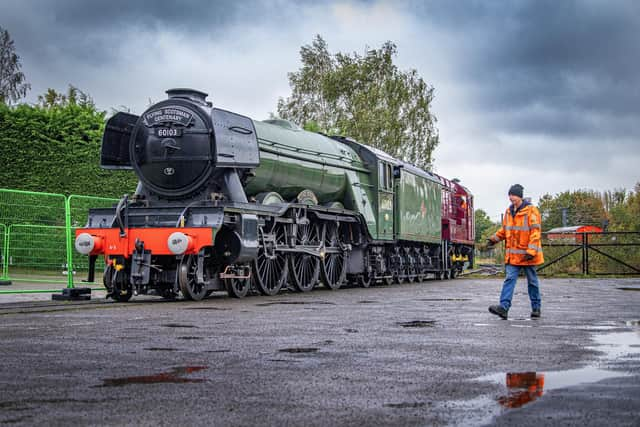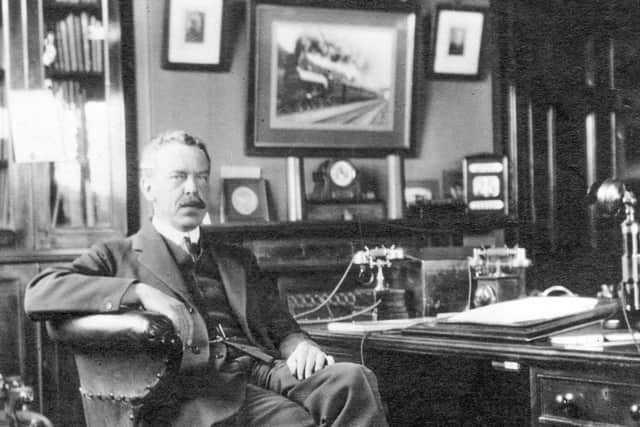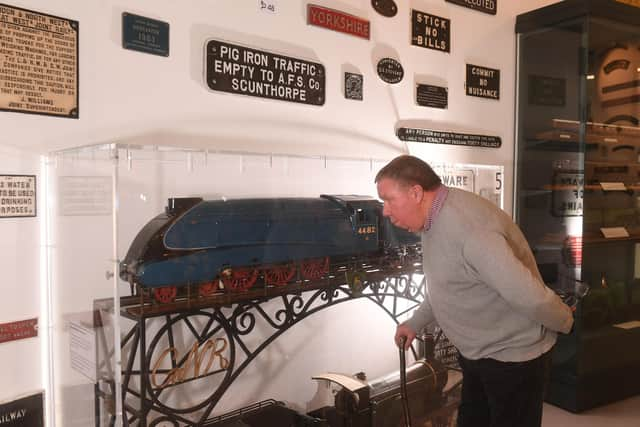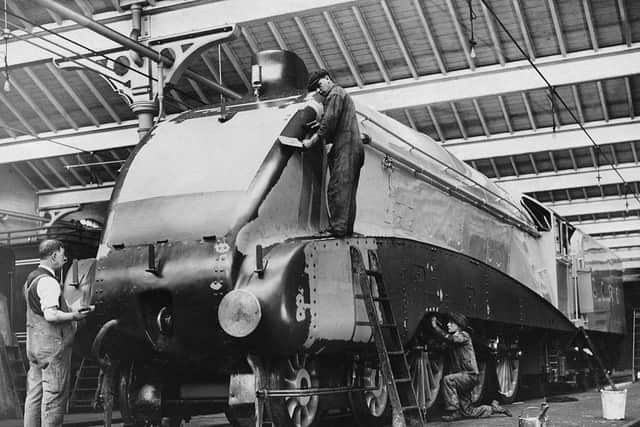The achievements of Sir Nigel Gresley - creator of The Flying Scotsman and Mallard locomotives
There are hundreds of photographs. Some portraits. A statue on the concourse of King’s Cross Station. A few newsreels. But there is not a single recorded second of the great man’s voice. Not the shortest of clips from the vast archives of the BBC, or of Pathé or Gaumont British News.
Since this man was one of the world’s leading engineers, who lived well into the age of sound, the omission is astonishing.
Advertisement
Hide AdAdvertisement
Hide AdSo, listening to Sir Nigel Gresley won’t be a pleasure for visitors to a new exhibition featuring his life and work. But they will be astonished at what else they’ll find – a treasure trove of artefacts that reveal the man and his genius, his skills, his personal life, and his amazing career. There’s much to enjoy – and a few tantalising mysteries to solve, as well.


The Edinburgh-born railway engineer was Chief Mechanical Engineer of the London and North Eastern Railway and famously designed the Flying Scotsman and Mallard steam locomotives, both built in Doncaster where the new exhibition is taking place.
One of the main exhibits is a fine portrait of Sir Nigel, painted by Sheffield artist William Ramsden Brealey. Works by Brealey can be found in art galleries across the country, and he specialised in portraits of the leading men and women of the day.
Brealey painted one of Sir Nigel in 1938, and the great man is shown sitting at his desk, papers in front of him, a signet ring on his finger, and a crisp white folder hankie in his jacket pocket.
Advertisement
Hide AdAdvertisement
Hide AdBut no-one quite knows the entire history of Brealey’s other portrait in the new exhibition.


As Neil McGregor, of Doncaster’s Danum Art Galley and Museum points out, if you look very closely (it has been painted on board, and not on canvas) you’ll see faint pencil marks which mark out the shape of the nose, and others which indicate that the artist marked it all out in squares before paint was applied. Was it created from a photograph, rather than an actual sitting? And, while it was owned by the Gresley family for many years (it will now be part of Danum’s own collection) who commissioned it in the first place? Was it the old LNER, where Gresley was the much-respected Chief Mechanical Engineer? And why would they pass it on to the family? Was it after his death on April 5, 1941, at the age of 64? And the inscription on the surface, is finely detailed – there’s not a single doubt about who the sitter was.
Gresley was knighted in July 1936. And he was one of the very few men to be given the accolade in the short but troubled reign of King Edward VIII – the monarch who abdicated the throne after a very public political turmoil.
Another of the items we can see is Gresley’s blue passport, which is liberally stamped by the then customs officials of many countries – Gresley seems to have enjoyed the South of France and Egypt quite a lot. But if you look at one of the front pages – the page with the personal details, you’ll see that it says Mr. Nigel Gresley, in ink. But, after the King’s sword descended on his shoulders, either Gresley, or one of his family, has drawn a line through the ‘Mr’, and written Sir, above it. In pencil.
Advertisement
Hide AdAdvertisement
Hide AdThe exhibition is a collaborative effort between the Museum, The Gresley Society and the Doncaster Grammar School Railway Collection Trust. Why the Grammar School? Well, back in the late 1930s some of the lads there were fascinated by model railways, and the headmaster of the day gave them permission to use some space in the then new art deco clock tower.


Like so many collections, from humble beginnings, it grew from some stretches of track, into a mammoth assembly of everything from tickets and leaflets to engine name-plaques, lamps, machines, signals, just about every conceivable piece of railway ephemera that you can imagine.
The collection – one of the best on the world, and internationally famous – is now held in more accessible premises in central Doncaster, where each and every one of the hundreds of thousands pieces is being painstakingly catalogued.
“There’s a very long way to go,” says Chris Ward, who himself was a pupil at the old Grammar School, and who is now a Trustee of the Doncaster collection, “a very, very long way indeed”.
Advertisement
Hide AdAdvertisement
Hide AdIt was during that move, from the top of the tower to today’s more accessible premises, that there was a major discovery. In some cabinets that were almost hidden from view, because so many other things had been piled up and around them, there were notebooks and letters which had been donated to the collection in 1963 by Doncaster man Harry Harper.


Harper, back then, was Gresley’s Chief Clerk. Today, he would have been known as his Personal Assistant. They tell of a growing trust, and a strong personal respect between the men. Chris Ward explains: “It certainly wasn’t all work-related, for Gresley sent letters while he was on holiday, saying that he was enjoying his break. But it shows the formality of the time that when the correspondence started, Gresley finished them with ‘Yours faithfully’, and when they ended, he was writing ‘Yours sincerely’, a rather more familial term.
“Harper, who also went to Doncaster Grammar School, was also employed by LNER, and he had the incredible good sense to keep Gresley’s letters and notebooks when the great man died. And, in time, he passed on the legacy to the School’s society. It was only when we were going through them that we realised that also here were the notebooks that the young Gresley wrote when he was little more than an apprentice with the Lancashire and Yorkshire Railway, and serving under another remarkable engineer John Aspinall."
Gresley then moved on to the Great Northern Railway, and then to his post at the newly-formed LNER.
Advertisement
Hide AdAdvertisement
Hide AdOne of Chris’ fellow Trustees, Chris Barron (also a former student at the school) says: “We now call them The Gresley Papers, and they are of incredible historic significance, showing meticulous detail, and the enquiring mind of the young Gresley. They have formed the impetus and inspiration for this exhibition.”
Philip Benham, the Chairman of the Gresley Society, says: “It’s a wonderful discovery, a direct connection to the man himself. And this wonderful exhibition is made all the more appropriate because Doncaster was where so many of Gresley’s remarkable achievements took place, and where many of his locomotives were built.”
Little is on record about Harry Harper – and both Societies would love to know more. Harper did live with his family for some time at Doncaster’s Prince of Wales pub – but that is now long demolished. “If anyone remembers anything about Harry”, says Chris Barron, “we’d love to hear more, do get in touch”.
The exhibition is opening on April 23 – 100 years to the day since one of Gresley’s finest engines, The Flying Scotsman, was unveiled at the British Empire Exhibition in Wembley.
Advertisement
Hide AdAdvertisement
Hide AdChris Ward adds: “I think that, while we all know that Sir Nigel was a true genius in his field, one of the great innovators, the exhibition tells us that he was also a very human person, far from an aloof figure. One of the exhibits is the family photo album, with snaps of him enjoying family life, and there’s also his famous hat, which he wore constantly. That’s here as well.
"Have any of us tried it on for size? Ah, well, that would be telling, wouldn’t it!”
Gresley: Genius of Steam and Speed, Danum Museum and Art Gallery, April 23 – September 21. Admission free.
Comment Guidelines
National World encourages reader discussion on our stories. User feedback, insights and back-and-forth exchanges add a rich layer of context to reporting. Please review our Community Guidelines before commenting.